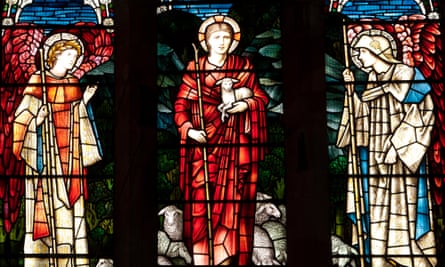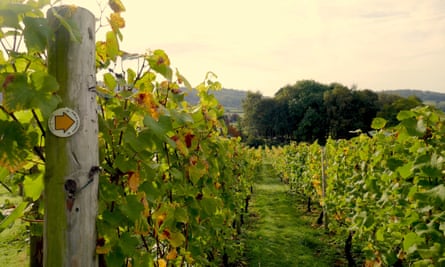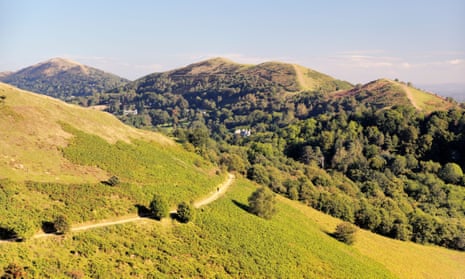Moreton-in-Marsh, Honeybourne, Evesham, Pershore … The names of the stations along the Cotswold Line railway are familiar as a nursery rhyme from childhood journeys. I grew up near Oxford, but it’s years since I last travelled west on this line and the distant hills have a blue, remembered air. The little River Evenlode meanders through sheep-dotted fields outside the train window before the wider Avon winds through plum and cherry trees. We cross the Severn among the spires and towers of Worcester and race under the Malverns to emerge near gnarled orchards, overgrown with mistletoe.
Herefordshire is a county for all seasons: once the leaves have fallen, there are glowing church windows, local jams and chutneys, original museums. There are wintry walks to enjoy, before the orchards blossom again, and mulled cider by log fires in half-timbered pubs. All Herefordshire buses are free for everyone at weekends until (it’s hoped) August 2022, with extra services on Sundays. It’s a scheme aimed at encouraging sustainable trips to local towns. I hop on a bus into Ledbury from the railway station, passing cobbled alleys and striking timber-framed houses. “A little town of ancient grace,” the Ledbury-born poet laureate John Masefield called his home town.
In the 12th-century parish church there’s a stained-glass Good Shepherd, designed by Edward Burne-Jones and made in William Morris’s workshop. More unusually, an old painting of The Last Supper, now restored and hanging behind the altar, was discovered this spring to be from the school of Titian. I follow the Geopark Way up towards Frith Wood for views across misty hills. A path back down towards the station, past hedges of rosehips and crab apples, runs through an orchard with dozens of different varieties of apple. Each tree stands in a pool of green or crimson windfalls, soon to become Wilces’ craft cider. The farm also rents out bikes (from £12/half day).

Back in town, the setting sun spills through old coaching inn archways along the western side of the High Street. Ledbury was a staging post on the road from Hereford to London. The newly refurbished Feathers Hotel, where I’m staying, is one of the oldest inns, kicking off the town’s fashion for black and white buildings (doubles from around £80, B&B, winter offer). I’m sleeping in a two-storey brick cottage off the courtyard, with a tall cherry tree outside and Masefield poems on the walls. Supper, in the Feathers’ restaurant, is a seasonal salad with spice-roasted chickpeas and smoked feta falafel (£15), followed by a citrus-y sugar-crisped lemon and pistachio cake (£7).
Soon after breakfast next morning (full veggie with fresh spinach, field mushrooms and tomatoes), I’m heading for a vineyard three miles north of Ledbury. I had planned to catch bus 675 from Ledbury to Loxter and walk the last mile, but the landscape and weather are so inviting that I set off on foot again through boot-soaking dew. I step off a lane and over a footbridge, a couple of hours later, into a sloping field of vines near a timber-framed brick farmhouse. The Geopark Way runs right through Coddington Vineyard and Visit Herefordshire have recently published a five-mile Wine Walk which includes it. There is wine for sale here on Fridays and Saturdays from March and you can stay year-round in a brick cottage or a wood-walled lodge surrounded by vines. The harvest is over, and owner Peter Maiden tells me the volume of grapes in 2021 was astounding, making up for 2020’s frosted crop.
The 10-mile walk from Ledbury to Great Malvern overflows with interesting sights. Round the corner, there’s more William Morris stained-glass in Coddington church. Next, I head for Luggs Mill orchard; the Colwall Orchard Group (COG) planted cherry trees here in 2017. I’m following the group’s heritage trail (£2) and soon reach the orchard-ringed allotments of the village garden, where COG have their HQ in an old apple-pressing hut. People are busy digging and harvesting among plots of pumpkins and raspberries, curly kale and marigolds. I buy a bottle of apple juice and chat to trustee Andy Ball about the visiting school parties who help with juicing and the group’s annual events: an Apple Day, a Mistletoe Fair, a January Wassail.

A mile further on, I reach Old Court Nurseries with its National Collection of Michaelmas daisies: 430 different varieties are blooming in shades of lilac, violet or magenta across the densely-packed acre-and-a-half of the Picton Garden. The garden reopens on 3 February, entry £4, for snowdrop season, with heritage narcissi budding not far behind. Then it’s time for butternut soup and bread at Café H2O in the GeoCentre, another mile on foot (or five minutes on bus 675), with a side order of hilly panoramas from the picnic tables. From here, it’s a relatively easy mile to the top of Worcestershire Beacon. Swigging apple juice from the bottle, I spin to survey the 360-degree views, feeling like Maria von Trapp crossed with Edward Elgar. The Malvern hills were an inspiration to the composer, who wrote the Enigma Variations. The path down into Great Malvern is much steeper, and the 40-minute bus ride back to Ledbury, past views over the sunset hills, feels gratifyingly long.
Olive trees and salvaged statues surround an inviting jumble of chairs and tables near a laden orchard as I hop off bus 476, on route to Hereford next morning, at the Nest farm shop and café. It’s a popular base for wintry walks, full of local crafts and produce: wine from nearby Sixteen Ridges vineyard, handmade Scotch eggs, and books of local hikes. The weather has turned colder and greyer so I relax inside on a re-upholstered cinema seat near the log burner with a big pot of tea; there are Herefordshire rarebits made with cider and deep slabs of quiche, with homemade coleslaw and apple chutney from the trees outside the window.

The bus rolls on again, through fields of hops and blackcurrants, into Hereford. My first stop is the Cider Museum (£3 for kids, £5.50 for adults). It’s a 15-minute stroll from the centre or frequent buses 71 and 72 run to nearby Ryelands Street. If you arrive in Hereford by train, you can add a PlusBus ticket for £3.60, which is valid on buses around the city for the whole day. The all-year museum, in Bulmer’s creeper-covered former factory, is full of stone mills and beam presses, bowl goblets and lead crystal flutes. My favourite room is a gallery of watercolour paintings of apples with evocative names: Redstreak, Siberian crab, Strawberry Norman, golden russet. There’s a cider tasting at the end and the shop has bottles of cider brandy from the museum’s own King Offa distillery.
Hereford cathedral glows, even on a dull day, with candles, up-lit Norman arches and chandeliers hung from gothic fan vaulting (free). Centuries of stained glass range from medieval fragments and slender lancets to Thomas Denny’s 2007 windows, celebrating the work of 17th-century Herefordshire poet and theologian, Thomas Traherne. “The world shall be a grand jewel of delight unto you,” wrote Traherne and these deeply-coloured windows gleam ruby, emerald and turquoise to conjure his visions of sun-gilded woods and streets whose stones are “precious as gold”. Nearby, the cathedral’s 13th-century calf-skin Mappa Mundi (map of the world) features fantastical satyrs and salamanders and there’s an ancient chained library (£6). The Mappa Mundi museum reopens on 24 January with an exhibition called All Things Bright, showcasing a shiny millennium of religious metalwork.
I end up at The Barrels, with half an hour before the last bus, drinking Wye Valley Bitter in an outdoor area hung with dried hops. In my bag is a picnic for the train tomorrow: a local ribstone pippin apple, a small spelt-and-honey sourdough (baked by Peter Cooks) from Fodder delicatessen, and a wedge of tangy oak-smoked Little Hereford (made at nearby Monkland Dairy) from the Mousetrap cheese shop. Walking through the misty streets to Ledbury station next morning, there’s a spirit-raising smell of ripe fruit and wet grass. Masefield wrote in his poem The West Wind:
“It’s a fine land, the west land, for hearts as tired as mine,
Apple orchards blossom there, and the air’s like wine.”
